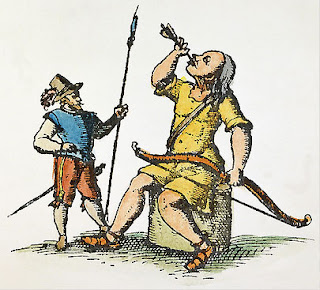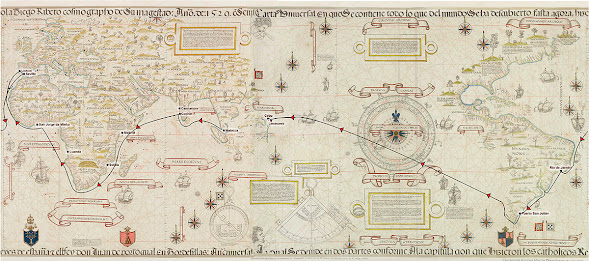 |
| Magellan sends crew member to copy Patagonian's dance. (Source: Butterworth.) |
Part 1 of series.
As they sailed off the map’s end, beyond the point where the last explorers charting South America's coast were killed and eaten by cannibals, Ferdinand Magellan’s crew came across a naked giant dancing and singing along the shore.
When Magellan's fleet came across the Tehuelches, an indigenous people in Patagonia, their imaginations took over. Wrote Pigafetta:
One day we suddenly saw a naked man of giant stature on the shore of the port, dancing, singing, and throwing dust on his head … He was so tall that we reached only to his waist, and he was well proportioned. His face was large and painted red all over while about his eyes he was painted yellow; and he had two hearts painted on the middle of his cheeks. His scanty hair was painted white. He was dressed in the skins of animals skillfully sewn together.
 |
| Patagonian giant on an early map. (Source) |
This was Europeans’ first encounter with the people Magellan called the Patagons—the Patagonian giants, as the world came to know them. The tall tales of later expeditions made the Patagonians even taller—ten feet or more. Sir Francis Drake saw them on his voyage through the strait. His nephew wrote in The World Encompassed, in 1628:
Magellan was not altogether deceived in naming these giants, for they generally differ from the common sort of man both in stature, bigness and strength of body, as also in the hideousness of their voices: but they are nothing so monstrous and giant-like as they were represented, there being some English men as tall as the highest we could see, but peradventure the Spaniards did not think that ever any English man would come hither to reprove them, and therefore might presume the more boldly to lie.
Reports of the giants sparked popular interest and the myth continued to grow well into the nineteenth century, when more-scientific reports brought the Patagonians’ height down to size. It’s likely that they were tall, six or seven feet, and statuesque, but they were being perceived by sixteenth-century Europeans who averaged just over five feet in height themselves. And read fantastic stories that came from Pliny the Elder.
Meanwhile—no surprise—chronicler Antonio Pigafetta was there to record a first impression of the giants, of their customs and language—and, noteworthy, the Europeans’ response to a Star Trek-like first contact moment:
The captain-general sent one of our men to the giant so that he might perform the same actions as a sign of peace. Having done that, the man led the giant to an islet into the presence of the captain-general. When the giant was in the captain-general’s and our presence, he marveled greatly and made signs with one finger raised upward, believing that we had come from the sky. …
The captain-general had the giant given something to eat and drink, and among other things which were shown to him was a large steel mirror. When he saw his face, he was greatly terrified, and jumped back throwing three or four of our men to the ground. After that he was given some bells, a mirror, a comb, and certain Pater Nosters. The captain-general sent him ashore with four armed men.
A Giant Named John
The fleet soon made contact with more of the Patagonians, including women. But the giants were wary of their visitors and kept a wise distance. One who was braver came to a small house the fleet built during their winter stopover for the smiths and for storage:
That man was even taller and better built than the others and as tractable and amiable. Jumping up and down, he danced, and when he danced, at every leap, his feet sank a palmo into the earth. He remained with us for a considerable number of days, so long that we baptized him, calling him Johanni. He uttered [the words] “Jesu,” “Pater Noster,” “Ave Maria” and “Jovani.”
Then the captain-general gave him a shirt, a woolen jerkin [camisota de panno], cloth breeches, a cap, a mirror, a comb, bells, and other things, and sent him away like his companions. He left us very joyous and happy. The following day he brought one of those large animals to the captain-general, in return for which many things were given to him, so that he might bring some more to us; but we did not see him again.
We thought that his companions had killed him because he had conversed with us.
The giant named John was not the only Patagonian to spend time with and be baptized by their European visitors. Two would depart with the fleet and become perhaps the most unlikely of explorers in Magellan's Armada de Molucca.
By John Sailors
EnriqueofMalacca.com
Images:
Top: Dancing Patagonian. Butterworth, Hezekiah. The Story of Magellan and the Discovery of the Philippines. Gutenberg.org..
Patagonian Series
Part 1, Magellan and the Patagonian Giants
Part 2, Paulo, Magellan's Patagonian Giant
(C) 2023, by John Sailors.
Profiles
• Enrique of Malacca, First Circumnavigator
• Ferdinand Magellan, Explorer-Conqueror
• Antonio Pigafetta, Magellan-Elcano Chronicler
• Duarte Barbosa, Magellan Ally w/ India Experience
• Juan Serrano, Magellan's Top Captain
• Charles V, Magellan's Royal Backer
• Joãozito Carvalho, 1st Brazilian to Cross Pacific
• Juan de Cartagena, Magellan Mutineer
• Paulo the Patagonian Giant
.
Frequently Asked Questions
• What was Enrique of Malacca’s Real Name
• What was Enrique of Malacca’s Cause of Death?
• Was Enrique First to Circumnavigate the Earth?
• Where was Enrique of Malacca from?
• Was Enrique of Malacca Filipino?
Enrique of Malacca Becomes First to Circumnavigate Globe
 |
| Map of Enrique of Malacca's circumnavigation: Malacca, Lisbon, Seville, Rio de Janeiro, Puerto San Julián, Guam, Limasawa, Cebu.[1] |
On March 28, 1521, Enrique of Malacca became the first person to complete a linguistic circumnavigation of the globe—he traveled so far in one direction that he reached a point where his own language was spoken. Enrique’s journey began a decade earlier following the sack of Malacca, when he was taken as a slave by Ferdinand Magellan. A teenager, he accompanied Magellan back to Portugal, then to Spain, and finally on the Armada de Molucca to locate a westward route to the Spice Islands. More about Enrique of Malacca.
- EnriqueOfMalacca.com
- Enrique of Malacca on Twitter
- Enrique of Malacca on Facebook
- John Sailors / Enrique on Medium
- And, yes, Enrique might be 500 years old, but he was known as a kid, so of course he's now on Instagram too.
